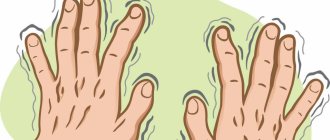- home
- Helpful information
- Rehabilitation issues
- Social and psychological maladaptation of older people
With maladaptation, a person gradually loses the ability to adapt to external conditions, interact with other people, the social environment, etc. For older people, this problem is especially serious. After retirement, as health deteriorates and mental problems arise, socio-psychological disadaptation occurs, and difficulties arise in interacting with the outside world.
Psychological disorders
Their set is determined by the causes of maladaptation, personality characteristics, and mental state. The following problems may occur.
Aggression. It becomes more difficult for an older person to communicate and interact with others. Because of this, negative thinking, hostility, and a negative attitude are formed. With maladjustment, the skill of finding a compromise, discussing, and developing agreements is lost. Instead, the person tries to achieve what he wants through direct aggressive behavior, pressure, or manipulation.
Closedness. In old age, there are fewer reasons to communicate with others, and almost all interests and social connections are gradually lost. Communication skills are lost, a person uses them less and less. He withdraws into himself, avoids any contact, becomes silent, prefers loneliness, strives to “protect” his mood, intentions, and attitudes from other people.
Egocentrism. Against the background of isolation and lack of communication, a person plunges deeper and deeper into his own inner experiences.
He is completely focused on himself, external events or conditions lose significance. Only his interests, desires, and motives become important. The ability to empathize and understand others sharply decreases. Egocentrism may be accompanied by deep feelings about one’s “uselessness” and isolation from society, but they do not lead to real actions. You have questions?
We will call you back within 30 seconds
or call the number
Clicking the "Submit"
, you automatically consent to the processing of your personal data and accept the terms of the User Agreement.
If such violations are not compensated for, behavior and emotional state will gradually worsen. Possible appearance:
- touchiness. Concentration on oneself, one's desires and needs provokes a severe reaction if the elderly person is left unattended. He may demand constant participation and be offended and worried when he does not receive it;
- suspiciousness, anxiety. The less interaction with the outside world, the more dangerous it begins to seem. Any events carry a threat, changes are always perceived negatively, only bad things can be expected from every situation;
- apathy, depression. Develops against the backdrop of refusal to communicate. The level of activity gradually decreases, interests are lost, and there is no desire to do ordinary things. Without correction, a person stops showing any initiative;
- illusions. They are usually negative in nature, and their appearance often provokes suspiciousness. Against this background, suspicion increases, and the attitude towards others and relatives can become hostile. This can create unhealthy illusions: an elderly person believes that they want to rob him, poison him, harm him, etc. Together with isolation, such beliefs can turn into a delusional state.
Causes
Let's start with the general level of physical and functional development of the child. Based on psychophysiological characteristics, the child may simply not be ready for school. Particular attention should be paid to this by parents who send their children to school from the age of 6.
The reason may lie in the characteristics of family upbringing. This may be permissiveness, the absence of restrictions and norms, or, conversely, complete control over the child’s actions by adults. The first entails the child’s negative attitude towards school, non-acceptance of norms and rules of behavior in the team, the second – the child’s inability to cope with school workloads, non-acceptance of routine issues
An important reason is the lack or impairment of motivation to study. At the initial stages of education, it may not be sufficiently formed and the task of parents is to make efforts to form it, because in older, teenage years, there may be a loss of interest in learning in general, and strong alternative motives will arise.
An important reason for inability to adapt to school life can be indiscipline, inattention, irresponsibility, but, as a rule, against the background of a fairly high level of the child’s cognitive abilities.
The inattentive attitude of parents and teachers to how children master the techniques of educational activities also disrupts the adaptation process.
Social disorders
Often associated with communication problems, decreased activity, changes in social status, and lifestyle.
Problems with meeting social needs. These are difficulties in communication and interaction with other people. They arise at all levels: from maintaining relationships within the family to one-time contacts with salespeople in stores, service workers, etc.
Difficulty maintaining social roles. These are problems with recognizing oneself as a pensioner, with changes in status in society and within the family, and the inability to adapt to them.
Frequent external or internal conflicts. An elderly person cannot do without them or maintain a calm state for a long time. This is associated with psychological disorders: suspiciousness, suspicion, anxiety, irritability.
Inability to perform social functions. They stay even after retirement. This could be helping friends, acquaintances, participating in raising grandchildren, running a household together with other family members, etc. Due to maladjustment, an elderly person may either refuse to perform such functions or lose the ability to do so.
Factors of social maladjustment
Social maladjustment is a fairly diverse phenomenon, which, in addition to symptoms, is also based on a number of factors that influence its character and complicate the individual’s social adaptation to the conditions surrounding him. Factors of social maladjustment include the following:
Finished works on a similar topic
Course work Factors of social maladjustment 410 ₽ Abstract Factors of social maladjustment 270 ₽ Test work Factors of social maladjustment 190 ₽
Receive completed work or specialist advice on your educational project Find out the cost
- Cultural and social deprivation, which can range from mild to severe. In this case, it is expressed in the fact that the individual is forcibly or at his own request deprived of various benefits and needs that play an important role in his life. Without these benefits, a person cannot exist normally, engage in a certain type of activity, or establish contacts with people for communication and exchange of information.
- Psychological and pedagogical neglect, which most often comes from the early childhood of an individual. Responsibility for neglect lies with the person’s parents, as well as with teachers who were inattentive and dismissive towards the individual.
- Overstimulation by new social values and norms. When entering a new environment, it is important for a person to gradually adapt and timely accept new norms. But if he enters the environment abruptly and is offered a large number of values, this leads to rejection and rejection. In addition, the person begins to experience discomfort and feels inferior because he thinks that he does not have sufficient skills to perceive new norms and conditions.
Also, factors of social maladaptation include insufficient preparedness for self-regulation processes (lack of knowledge and skills to take advantage of new norms and values); loss of established forms of mentoring (loss of family, guardian, teacher); loss of the usual team (due to illness, change of activity, moving to another country); low degree of psychological readiness to master the profession (insufficient level of communication, responsibility, desire to work on one’s mistakes and gain new knowledge); breaking dynamic stereotypes, character accentuations, psychopathic personality formation in conflict conditions.
Risk factors for social and psychological maladjustment in older people
Loneliness. It is considered the main provoking moment. The person becomes isolated and communicates less. Gradually, communication skills are lost, and existing emotional problems become more acute. This triggers maladaptation, which quickly becomes uncontrollable. It is impossible to cope with it on your own. Negative changes occur especially quickly if there are no relatives or loved ones nearby.
Social environment. In Russia, it is considered one of the most “unfriendly” towards older people. Social services are minimal and not available to all pensioners. Volunteer activities are carried out in limited quantities. The elderly have almost no “platforms”, opportunities for communication, or the formation of new interests. Starting from a certain age, a person finds himself in isolation: it becomes increasingly difficult for him to maintain a normal amount of communication and social activity, even if he wants to do it.
Personality characteristics. With age, unpleasant character traits can “sharpen” and appear more clearly. This increases maladaptation - negative thinking becomes dominant, and the level of criticism of one’s own actions decreases.
Prevention of maladjustment in older people
It is important for an elderly person to remain active, to feel needed and useful. The key role in this is played by the close environment, the family. It is important to maintain a wide (but feasible) range of responsibilities for as long as possible, emphasize the importance of an elderly relative, communicate with him as much as possible, and involve him in participation in family life. Contact with peers and representatives of other generations, a high level of social activity, participation in public affairs, volunteering, etc., protect well from maladjustment.
Another direction of prevention is medical control. Med recommends regular examination by a psychotherapist or psychiatrist. With age, cognitive impairment, pathological conditions and diseases appear that require medical supervision. It is important to diagnose them in time. This will help delay the onset of maladjustment or avoid it altogether.
Sign up for a consultation
- Choosing a rehabilitation center
- Stages of rehabilitation
- Massage as a means of rehabilitation
- Drawing up rehabilitation programs
- Treatment of senile dementia
- Hallucinations in the elderly
- Rehabilitation after strokes
- Rehabilitation after traumatic brain injuries
- Therapeutic exercise in rehabilitation after injuries and diseases
- Laboratory diagnostics during the rehabilitation period
- Social and psychological maladaptation of older people
- Physical activity in rehabilitation of the elderly
- Diet therapy as part of rehabilitation of the elderly
- Rehabilitation of elderly people with alcohol dependence
- Clinical syndromes characteristic of older people and methods of correction
- Medical rehabilitation for dementia
School maladjustment: diagnosis, correction, prevention article
How a child will feel when climbing the first step of the ladder of knowledge
what he will worry about
his entire further path to knowledge depends.
V. Sukhomlinsky
School maladjustment: diagnosis, correction, prevention
School maladjustment is a violation of the child’s adequate mechanisms of adaptation to the school environment, affecting his educational productivity and relationships with the outside world.
According to psychologists, schoolchildren who experience difficulties in adaptation may have problems mastering school material, resulting in low academic performance, as well as difficulties in forming social contacts both with peers and with adults. Parents and teachers, of course, should know what to pay attention to in order to prevent unfavorable developments.
Causes of maladjustment at school
Among the reasons for maladjustment in the school community, the most common are the following: inability to find contact with peers, poor academic performance, and the child’s personal characteristics.
The first reason for maladaptation is the inability to build relationships in a children's team. Sometimes a child simply lacks such a skill. Unfortunately, not all children find it equally easy to make friends with their classmates. Many simply suffer from increased shyness and do not know how to start a conversation. Difficulties in establishing contact are especially relevant when the child enters a new class with already established rules. Many people withdraw into themselves and refuse to attend school under any pretext. This is how maladaptation to school is formed.
Another reason is falling behind in classes. If a child does not understand something, then he gradually loses interest in the subject and does not want to do his homework. Having experienced learning difficulties, some children refuse to study at all, not wanting to again face numerous difficulties and misunderstandings.
The personal characteristics of a child can also become a certain prerequisite for the formation of maladjustment. An overly shy child is often bullied by his peers or even given lower grades by his teacher. Someone who does not know how to stand up for himself often has to suffer from maladaptation, since he cannot feel significant in the team. Each of us wants our individuality to be valued, and for this we need to do a lot of internal work on ourselves. A small child is not always able to do this, which is why maladjustment occurs. There are also other reasons that contribute to the formation of maladjustment, but they are, one way or another, closely related to the three listed.
Problems with school among elementary school students
When a child first enters first grade, he naturally experiences anxiety. Everything seems unfamiliar and frightening to him. At this moment, the support and participation of his parents is more important than ever for him. Disadaptation in this case may be temporary. As a rule, after a few weeks the problem resolves itself. It just takes time for the child to get used to the new team, be able to make friends with the guys, and feel like a significant and successful student. This does not always happen as quickly as adults would like.
Disadaptation of younger schoolchildren can be associated with their age characteristics. The age of seven to ten years is not yet conducive to the formation of special seriousness towards school responsibilities. To teach a child to prepare homework on time, one way or another, you need to supervise him. Not all parents have enough time to monitor their own child, although, of course, they should set aside at least an hour every day for this. Otherwise, maladjustment will only progress.
School problems can subsequently result in personal disorganization, lack of self-confidence, that is, reflected in adult life, making a person withdrawn and unsure of himself.
How to determine whether a first-grader child has adapted to school or not? How successful was the adaptation? How to avoid the risk of maladjustment?
Currently, there are many methods for determining the level of maladaptation of first-graders. In my work I use the questionnaire proposed by L.M. Kovaleva, which helps to systematize the idea of a child starting to study at school. The named technique is addressed to primary school teachers. It consists of the following 46 statements, 45 of which relate to possible options for a child’s behavior at school, and one concerns the participation of parents in upbringing.
The questionnaire is easy to research and helps the teacher systematize ideas about a child starting to study at school. All statements are grouped by child behavior factors. This construction allows the teacher to quickly navigate and determine which factor (or group of factors) underlies maladjustment.
| № | Index | Criteria | |
| 1 | Parental attitude | RO |
|
| 2 | Not ready for school | NGSH |
|
| 3 | Left-handedness | L |
|
| 4 | Neurotic symptoms | NS |
|
| 5 | Infantilism | AND |
|
| 6 | Hyperkinetic syndrome (excessive disinhibition) | HS |
|
| 7 | Inertia of the nervous system | ANN |
|
| 8 | Insufficient arbitrariness of the psyche | NP |
|
| 9 | Low motivation | NM |
|
| 10 | Asthenic syndrome | AC |
|
| 11 | Intellectual disability | NID |
|
| answer form | ||
| 1 | RO | |
| 2 | 3 4 | NGSH |
| 5 6 | L | |
| 7 8 9 | 10 11 | NS |
| 12 13 14 | 15 16 | AND |
| 17 18 19 | 20 21 | HS |
| 22 23 | 24 25 26 | ANN |
| 27 | 28 29 30 | NP |
| 31 32 33 | 34 35 | NM |
| 36 | 37 38 39 40 | AC |
| 41 42 | 43 44 45 46 | NID |
When working with a questionnaire using this method, the teacher must cross out the numbers on the answer form that describe fragments of behavior characteristic of a particular child.
The form is divided by a vertical line. If the crossed out number is to the left of the line, then during processing it gives one point, if to the right - two points. The maximum score is 70. By calculating the number of points a student has scored, you can determine his maladaptation coefficient: K = n / 70 • 100, where n is the number of points scored by the first-grader.
Analysis of the obtained results allows us to interpret the coefficient values as follows:
- an indicator of up to 14% is normal;
These are well-adapted first-graders, because they easily integrated into school life. These children are mainly from prosperous families, where parents pay a lot of attention to their development and talk about school. They are well prepared for school, have a wide range of cognitive interests, easily enter into communicative relationships with the teacher and peers, and enjoy working in class. Such qualities allowed them to feel their success.
- an indicator from 15 to 30% indicates an average degree of maladjustment;
Children are characterized by uneven development, i.e. at sufficiently high rates of development of thinking, arbitrariness of behavior suffers. These students are infantile, they are often distracted in class, so they do not have time to complete the task on time or answer correctly, they require constant attention from the teacher, they do almost everything after repeated requests “Write”, “Work”... this group includes students who previously did not attend kindergarten. They have a hard time getting used to the new environment, regime, and requirements. This group includes children with poor development of fine motor skills. They are recommended to do finger exercises and finger massage. This also includes first-graders with intellectual disabilities. Such students need to put in a lot of effort to achieve success.
- an indicator of over 30% indicates a serious degree of maladjustment; With this combination of factors, the learning process is especially difficult, because These first-graders are attracted only by things that interest them, and simple educational material is not perceived. They behave very noisily during lessons and breaks, do everything quickly and haphazardly, switch from one type of activity to another with great difficulty, and easily come to terms with failures. They do not like to make efforts to complete tasks. Such students almost never answer questions that require intelligence; they count on their fingers, do not know how to highlight the main thing, or apply previously learned rules when explaining new material.
- if the coefficient is over 40%, then the student, as a rule, needs to consult a neuropsychiatrist.
Summary table of the results of the adaptation period ___ 1st grade
Behind "___" ___________ __________
| № | F.I. | Indicators of maladjustment | Koof-t maladjustment (a/70)* 100 A - number of points | |||||||||||
| Parental attitude RO | Not ready for school NGSH | Left-handedness L | Neurotic symptoms NS | Infantilism AND | Hyperic. Symptom (excessive disinhibition) HS | Inertia of the nervous system ANN | Insufficient arbitrariness of the psyche NP | Low motivation NM | Asthenic syndrome AC | Intellectual disability NID | ||||
| Number of points | % disadaptation | |||||||||||||
| Indicators in 1 point | 1 | 2 | 5 6 | 7 8 9 | 12 13 14 | 17 18 19 |
| 27 |
| 36 |
| |||
| Indicators in 2 points | 3 4 | 10 11 | 15 16 | 20 21 | 24 25 26 | 28 29 30 | 34 35 | 37 38 39 40 | 43 44 45 46 | |||||
| 1 | child's FI | |||||||||||||
Conclusion on average for the class passing the adaptation process:
Successful (full) adaptation (more than 86%) _______people (_______%)
Partial adaptation (70% - 85%) _____ people (_______%)
Serious deviations in the process (risk group) (60% - 69%) ______ people (______%)
Severe degree (consultation with a neuropsychiatrist) (below 60%) _____ people ( ______ %)
Correction of school maladjustment
If it turns out that your child is experiencing certain difficulties in class, you should definitely begin to take active measures to eliminate the problem. The sooner this is done, the easier it will be for him in the future. Correction of school maladjustment should begin with establishing contact with the child himself. Building trusting relationships is necessary so that you can understand the essence of the problem and together get to the roots of its occurrence. The methods listed below will help cope with maladaptation and increase your child’s self-confidence.
Conversation method
If you want your child to trust you, you need to talk to him. This truth should never be ignored. Nothing can replace live human communication, and a shy boy or girl simply needs to feel significant. It is not necessary to immediately start asking about the problem. Just start by talking about something extraneous and unimportant. The baby will open up on his own at some point, don’t worry. There is no need to push him, interrogate him, or give premature assessments of what is happening. Remember the golden rule: do no harm, but help overcome the problem.
Art therapy
Invite your child to draw on paper his main problem. As a rule, children suffering from maladaptation immediately begin to draw pictures of school. It is not difficult to guess that this is where the main difficulty lies. Don't rush or interrupt while drawing. Let him express his soul fully, ease his inner state. Maladjustment in childhood is not easy, believe me. It is also important for him to be alone with himself, to discover his existing fears, and to stop doubting that they are normal. After the drawing is completed, ask your child what's what, referring directly to the image. This way you can clarify some significant details and get to the origins of maladjustment.
We teach to communicate
If the problem is that the child has difficulty interacting with others, then you should work through this difficult moment with him. Find out what exactly the difficulty of maladaptation is. Perhaps it is a matter of natural shyness or he is simply not interested in being with his classmates. In any case, remember that for a student to remain outside the team is almost a tragedy. Disadaptation deprives one of moral strength and undermines self-confidence. Everyone wants recognition, to feel like an important and integral part of the society in which they are located. When a child is bullied by classmates, know that this is a difficult test for the psyche. This difficulty cannot simply be brushed aside and pretended that it does not exist at all. It is necessary to work through fears and raise self-esteem. It’s even more important to help re-enter the team and feel accepted.
"Problematic" item
Sometimes a child is haunted by failure in a particular discipline. Rarely will a student act independently, seek the teacher’s favor, and study additionally. Most likely, he will need help with this, to direct him in the right direction. It is better to contact a specialist who can “pull up” on a specific subject. The child should feel that all difficulties can be solved. You can’t leave him alone with the problem or blame him for the fact that the material is badly neglected. And we certainly shouldn’t make negative predictions about his future. This causes most children to break down and lose all desire to act.
The problem of maladjustment at school requires careful attention. Help your child cope with his inner pain, do not leave him alone with difficulties that probably seem insoluble to the child.
Correction of maladjustment
Correction of maladjustment requires an individual approach, which takes into account:
- age characteristics;
- individual personal characteristics;
- manifestations and root causes of maladjustment;
- development environment conditions.
A popular mistake in working to correct maladjustment is fighting the symptoms that have appeared. For example, a child asserts himself through fights. It is useless to punish him for fighting and prohibit him from doing so. Even if he stops fighting, he will do something else, for example, vandalism, since the need for self-affirmation will remain, and the child still does not know the correct methods. Accordingly, the goal of the work is to help the child assert himself in a socially acceptable way.
So what can you do:
- Identify the child’s abilities and interests.
- Identify problems that accompany the need for self-affirmation, for example, uncertainty or fears.
- Help the child overcome problems and do useful and interesting things, for example, join a club, take up drawing or sports, play KVN, and so on.
Using the same principle, you need to work with a child’s aggression and rudeness. Perhaps this is an overcompensation for self-doubt and inability to communicate. Accordingly, we teach how to communicate and be confident - rudeness goes away on its own.
There is no need to be afraid of maladaptation, much less to hush up the problem. Most schoolchildren have problems adapting. Unfortunately, this is a popular problem, but in the early stages it can be easily corrected.
Prevention of school maladjustment
Prevention of school maladjustment is to prevent the development of unfavorable situations. When one or more students find themselves emotionally isolated from the rest, the psyche suffers and trust in the world is lost. It is necessary to teach how to resolve conflicts in a timely manner, monitor the psychological climate in the classroom, and organize events that help establish contact and bring children closer together.
The work should be carried out jointly by parents and school specialists:
- the psychologist draws up recommendations and an individual development plan for the child;
- parents monitor compliance with recommendations within the home (assistance in mastering knowledge, control over the completion of lessons, analysis of missed or incomprehensible material);
- The teacher helps the child in the classroom: creates situations of success, monitors the healthy psychological climate and adherence to an individual-personal approach.
It is important to remember the overall goal - to help the child adapt. The unity of parents and teachers contributes, at a minimum, to reducing the level of anxiety in the child.
Bibliography:
- Questionnaire for studying the characteristics of first-graders’ adaptation to school. https://medlec.org/lek3-83507.html - L. M. Kovaleva, N. N. Tarasenko
- “School maladaptation of first-graders and methods for its diagnosis” Koleganova Tatyana Anatolyevna https://nsportal.ru
- School maladjustment. https://psyh.info
- Psychological and pedagogical monitoring https://gigabaza.ru/download/49732.html/
- https://psychologist.tips/254-sposobnosti-v-psihologii-i-ih-vidy.html
- https://psychologist.tips/44-kak-pomoch-rebenku-stat-uverennym-v-sebe-sovety-psihologa.html
- https://psychologist.tips/162-kak-izbavitsya-ot-straha-sovety-psihologa.html











